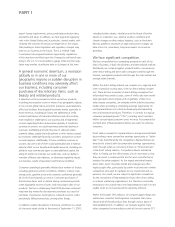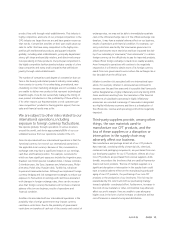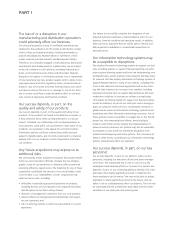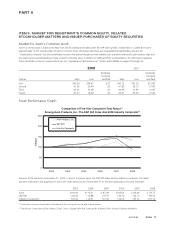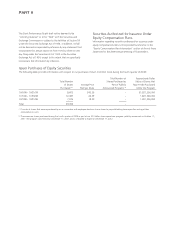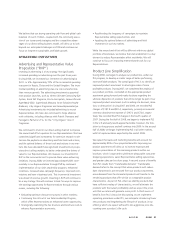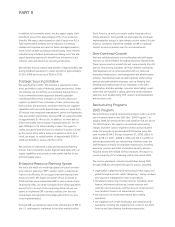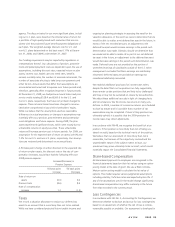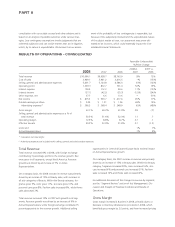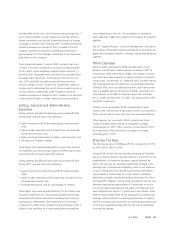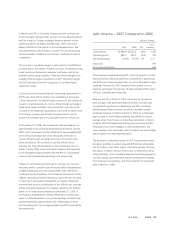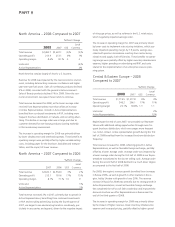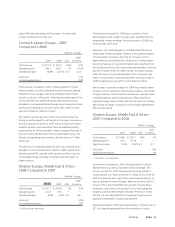Avon 2008 Annual Report Download - page 28
Download and view the complete annual report
Please find page 28 of the 2008 Avon annual report below. You can navigate through the pages in the report by either clicking on the pages listed below, or by using the keyword search tool below to find specific information within the annual report.PART II
In addition to the benefits above, we also expect supply chain
benefits to account for approximately 15% of our projected
benefits. We expect improvements to cost of sales once PLS is
fully implemented, primarily from a reduction in inventory
obsolescence expense as a result of better managed inventory
levels, lower variable spending on warehousing, more efficient
manufacturing utilization and lower purchasing costs. We also
expect operating expenses to benefit from a reduction in dis-
tribution costs and benefits to inventory productivity.
We estimate that we realized total benefits of approximately $40
during 2008 and we expect to realize benefits of approximately
$120 in 2009 and in excess of $200 in 2010.
Strategic Sourcing Initiative
We launched SSI in 2007. This initiative is expected to reduce
direct and indirect costs of materials, goods and services. Under
this initiative, we are shifting our purchasing strategy from a
local, commodity-oriented approach towards a globally-
coordinated effort which leverages our volumes, allows our
suppliers to benefit from economies of scale, utilizes sourcing
best practices and processes, and better matches our suppliers’
capabilities with our needs. Beyond lower costs, our goals from
SSI include improving asset management, service for Representa-
tives and vendor relationships. During 2008, we realized benefits
of approximately $114 from SSI. In addition, we were able to
offset commodity cost increases of approximately $21 for full-
year 2008 due to SSI actions already in place. We expect to
realize annualized benefits from this initiative in excess of $250
by the end of 2009, with a full year of benefit in 2010. As a
result, we expect to realize benefits of approximately $200 in
2009 and benefits in excess of $250 in 2010.
We continue to implement a Sales and Operations Planning
process that is intended to better align demand plans with our
supply capabilities and provide us with earlier visibility to any
potential supply issues.
Enterprise Resource Planning System
We are in the midst of a multi-year global roll-out of an enter-
prise resource planning (“ERP”) system, which is expected to
improve the efficiency of our supply chain and financial trans-
action processes. We began our global roll-out in Europe in
2005 and have since implemented ERP in our European manu-
facturing facilities, our larger European direct selling operations
and in the U.S. As part of this continuing global roll-out, we
expect to implement ERP in several countries over the next
several years leveraging the knowledge gained from our pre-
vious implementations.
During 2008, we worked to improve the effectiveness of ERP in
the U.S. and began to implement in the other markets within
North America, as well as in certain smaller European direct
selling operations. During 2008, we also began the multi-year
implementation process in Latin America in one market. In Latin
America, we plan to implement modules of ERP in a gradual
manner across key markets over the next several years.
Zero-Overhead-Growth
We have institutionalized a zero-overhead-growth philosophy
that aims to offset inflation through productivity improvements.
These improvements in productivity will come primarily from SSI
and our restructuring initiatives. We have defined overhead as
fixed expenses such as costs associated with our sales and
marketing infrastructure, and management and administrative
activities. Overhead excludes variable expenses within selling,
general and administrative expenses, such as shipping and
handling costs and bonuses to our employees in the sales
organization, and also excludes consumer and strategic invest-
ments that are included in selling, general and administrative
expenses, such as advertising, RVP, research and development
and brochure costs.
Restructuring Programs
2005 Program
We launched our original restructuring program under our multi-
year turnaround plan in late 2005 (the “2005 Program”). In
January 2008, we announced the final initiatives that are part of
the 2005 Program. We expect to record total restructuring
charges and other costs to implement restructuring initiatives
under this program of approximately $530 before taxes. We
have recorded $504.2 through December 31, 2008, ($60.6 in
2008, $158.3 in 2007, $228.8 in 2006 and $56.5 in 2005) for
actions associated with our restructuring initiatives under the
2005 Program, primarily for employee-related costs, including
severance, pension and other termination benefits, and pro-
fessional service fees related to these initiatives. We expect to
record a majority of the remaining costs by the end of 2009.
The costs to implement restructuring initiatives during 2005
through 2008 are associated with specific actions, including:
• organization realignment and downsizing in each region and
global through a process called “delayering,” taking out layers
to bring senior management closer to operations;
• the phased outsourcing of certain services, including certain
finance, information technology, human resource and
customer service processes, and the move of certain services
from markets to lower cost shared service centers;
• the restructure of certain international direct-selling
operations;
• the realignment of certain distribution and manufacturing
operations, including the realignment of certain of our North
America and Latin America distribution operations;


